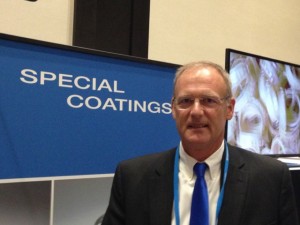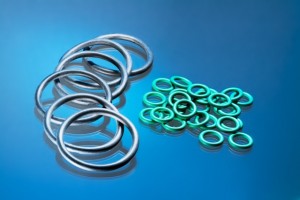SEATTLE – A 19-year-old German company with an established surface-coating technology for small parts is tumbling its way into the Americas. That company, Special Coatings GmbH & Co. KG, opened its first U.S. facility on Aug. 1 in Bonita Springs, Fla., and now faces the challenge of educating potential customers about how and why its proprietary process works.

Special Coatings USA LLC began sales efforts in North America earlier this year and exhibited at the NPE 2015 trade show in Orlando, but only just began operations in its 4,950-square-foot facility in Florida, according to President Douglas Treadwell. Speaking in an Aug. 22 interview at the Industrial Designers Society of America international conference in Seattle, where the firm was exhibiting, Treadwell noted that Special Coatings also plans on Dec. 8 to open its first facility in China, in the southern industrial city of Shenzhen.
The key to the process is the SC-Coater drum coating machine. The privately held German company developed the machine in 2005 in response to requests from customers who were frustrated with existing coating processes, which Treadwell said inefficiently wasted paint, applied uneven coatings, and often suffered from streaks and runs. The paint overspray with such systems often ran between 20-70 percent and on some parts, such as bezel rings, could be as high as 90 percent, he said. The thinnest coatings typically were 20-30 microns thick.
The patented SC-Coater machine has a footprint of roughly 10 by 10 feet, with a rotating drum that measures approximately 40 by 16 inches, and an internal volume of 60-80 liters. It can handle pieces up to about 6 inches square, and depending on part size, the drum can take from 200 to 40,000 pieces at a time. There are weight restrictions on the pieces being coated, since overly heavy pieces can damage one another as they tumble in the drum. The lacquer is applied using up to two computer-controlled spray heads.

Treadwell claims a 95 to 97 percent coating efficiency with this system, and notes that the coating thicknesses range from just 5 to 12 microns. This means the coated parts retain the integrity of the substrate, allowing textures and patterns to show through. The very thin coating also means it doesn’t crack when bent.
An infrared radiator built into the drum’s door heats only the pieces themselves (not the air), and only to about 40 degrees C – or about half the temperature often needed with competitive systems. The lower temperature prevents degradation of the substrate, which previously could lead to a failure rate of 20-30 percent with other processes, causing O-rings, for example, to lose their elasticity.
Special Coatings in Germany had to re-engineer its lacquers for use in its machine, which work now only with SC’s proprietary coating materials.
“Since ours is a ‘color on’ rather than a [molded] ‘color in’ system,” Treadwell said, “our parts can have more luster,” to include glossy, pearlized or metallic finishes. “We can match any color, and customize every finish” to each customer’s wishes, he added. Current applications include knobs and hinges in the household products sector, as well as toys and small packaging.
He said one cosmetics company customer, for example, has used this process to make its eyeliner cases look metallic (instead of like glossy plastic), and as a result has been able to move it up to a higher-price-point customer category. One customer questioned if a metal golf tee would damage his club head – till Treadwell explained it was, in fact, a plastic tee that only happened to look like metal.
The firm is supplying customers such as appliance giant Bosch Siemens, window and door hardware manufacturer Roto Frank AG, and Brandstätter Group, maker of the Playmobil line of toys.

The SC-Coater can coat some small, lightweight metal pieces (such as screws), as well as small elastomeric and ceramic parts, but mostly focuses on the nearly full palette of plastics substrates – everything but polyoxymethylene (POM, or aka acetal) resin, which is formulated to keep anything from sticking to it. The coated pieces are hit with an atomized spray as they tumble inside the drum, and they dry instantly, meaning no curing time is needed.
“It’s a very low labor process,” Treadwell said. “We handle the parts only two times – putting them in and taking them out of the drum. “Most of our customers tell us our system is about 10 percent less expensive than their previous painting process, while also yielding better quality.”
He said SC also can produce samples in quantities as few as 20 pieces, and that the production parts are exactly the same as the prototypes. The machine can be used to apply purely decorative coatings (metallic effects, matte galvanized finishes, clear or matte varnishes), as well as functional coatings (scratch-resistant, corrosion-protection, anti-friction or primers).
The new facility in Bonita Springs will serve all of the Americas. The German firm has been active in China for less than a year, and plans to open its new Shenzhen facility with two SC-Coater machines, Treadwell said.
The process itself has been in use for a decade, and Special Coatings has worked out any bugs that might have existed, Treadwell said. The company’s biggest challenge now, he said, is simply “getting people to understand it.”
(See a detailed video of the process in action at www.special-coatings.com.)
Search for materials on Prospector.com…
The views, opinions and technical analyses presented here are those of the author or advertiser, and are not necessarily those of ULProspector.com or UL Solutions. The appearance of this content in the UL Prospector Knowledge Center does not constitute an endorsement by UL Solutions or its affiliates.
All content is subject to copyright and may not be reproduced without prior authorization from UL Solutions or the content author.
The content has been made available for informational and educational purposes only. While the editors of this site may verify the accuracy of its content from time to time, we assume no responsibility for errors made by the author, editorial staff or any other contributor.
UL Solutions does not make any representations or warranties with respect to the accuracy, applicability, fitness or completeness of the content. UL Solutions does not warrant the performance, effectiveness or applicability of sites listed or linked to in any content.



Leave a Reply or Comment